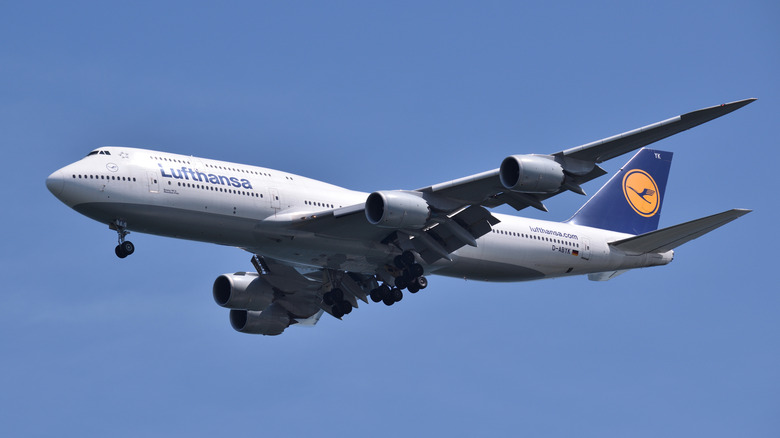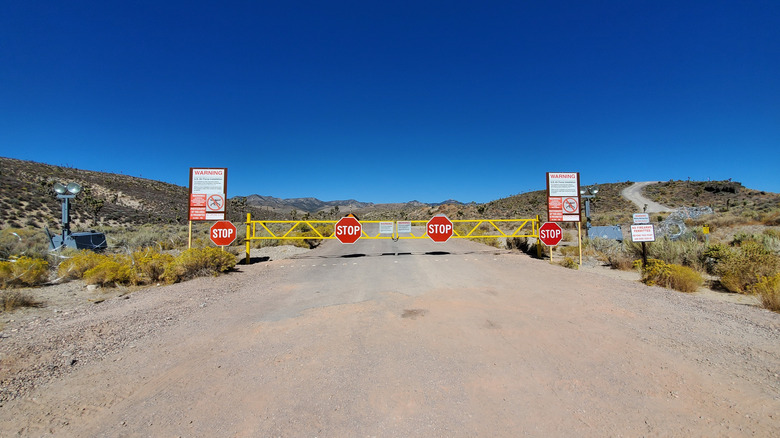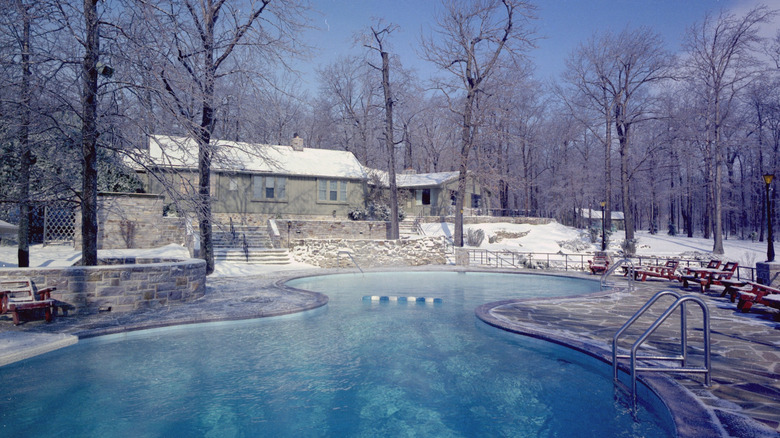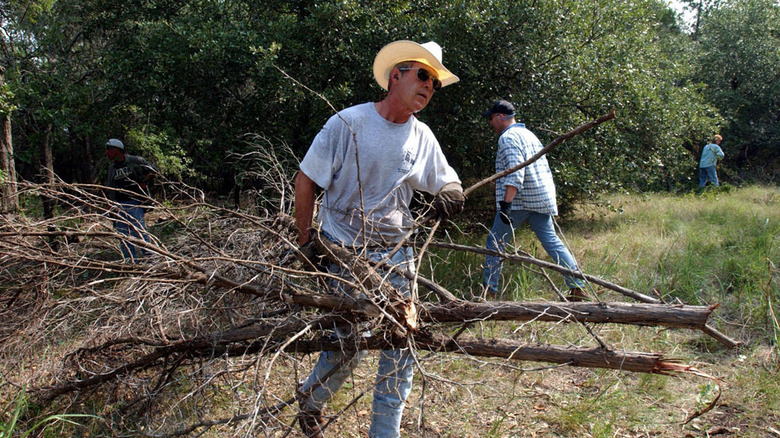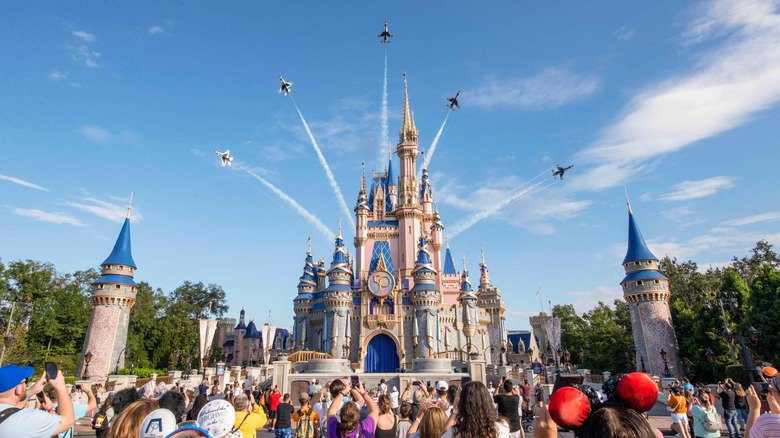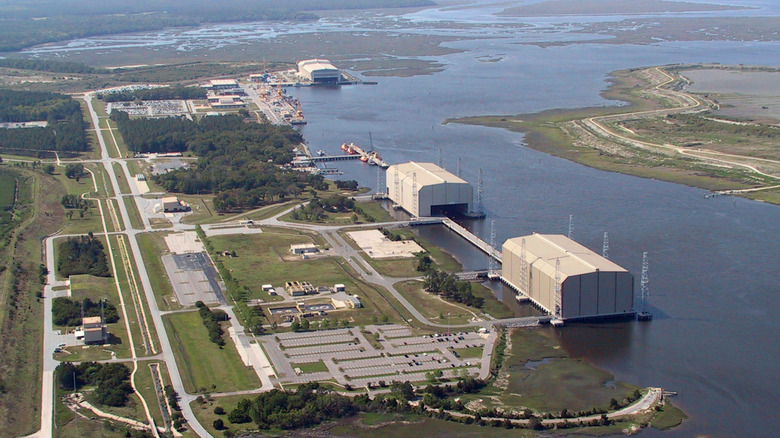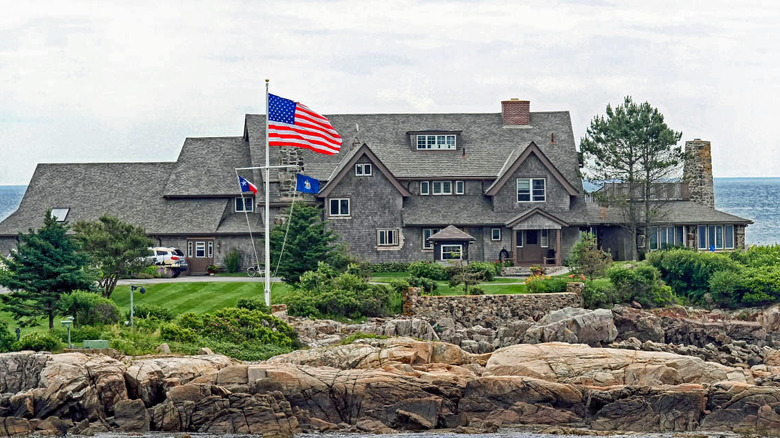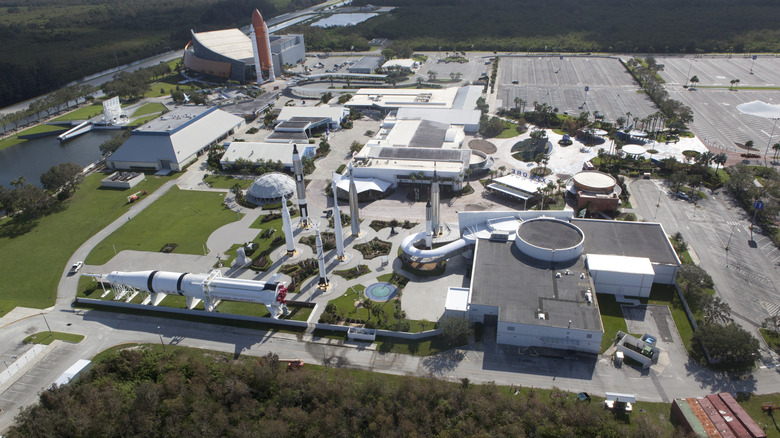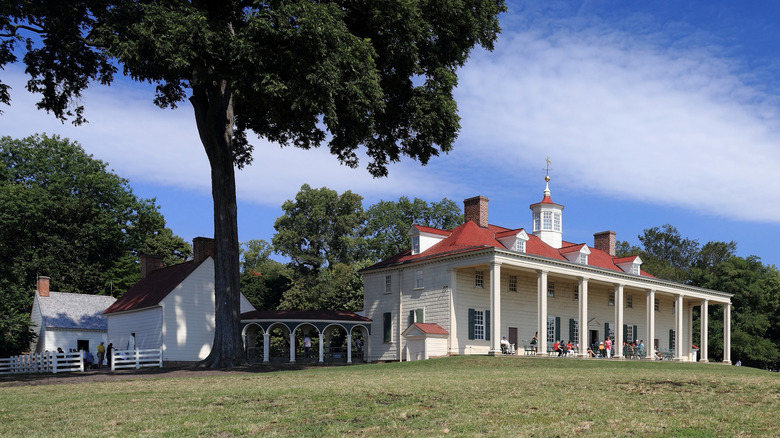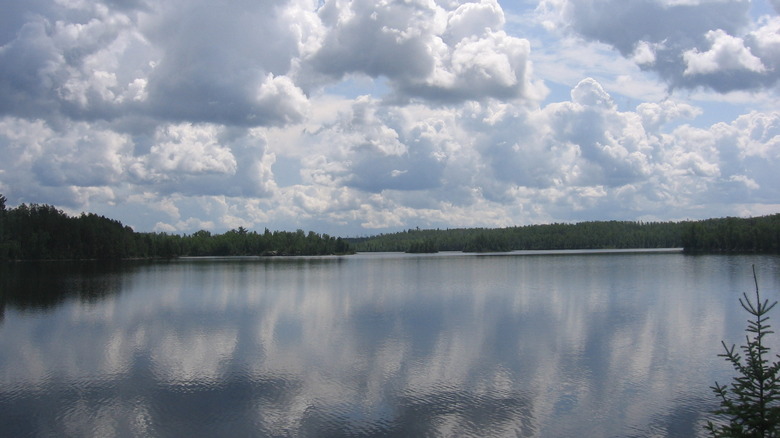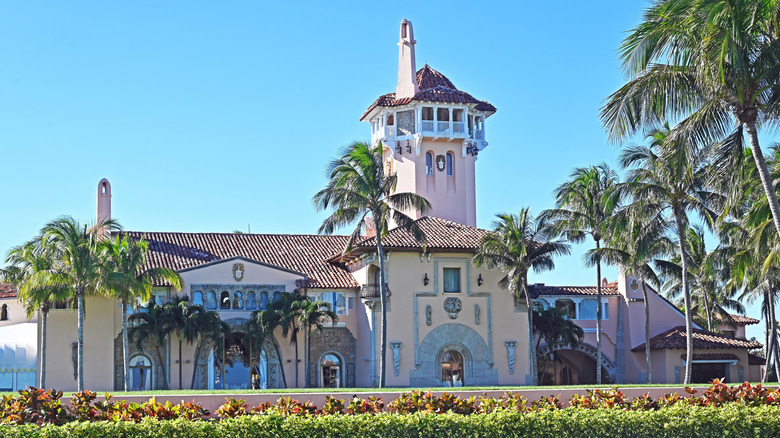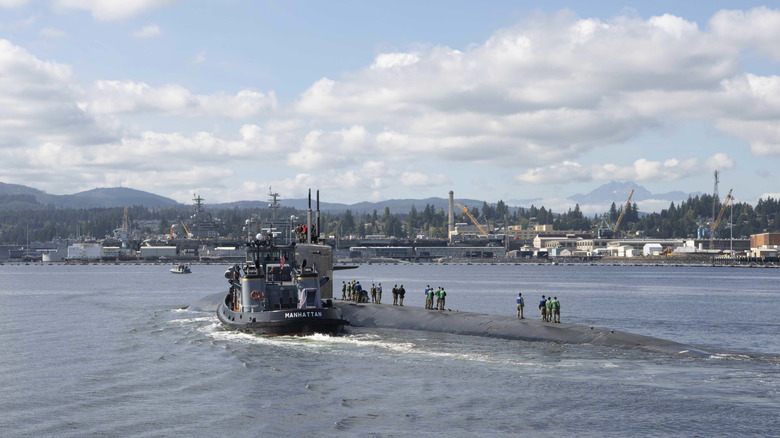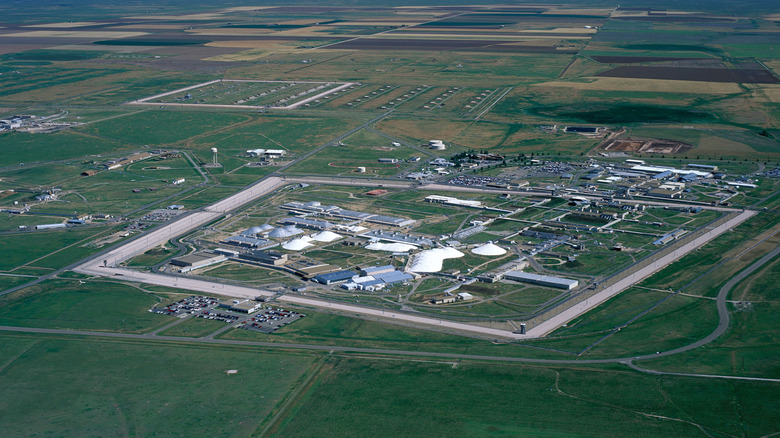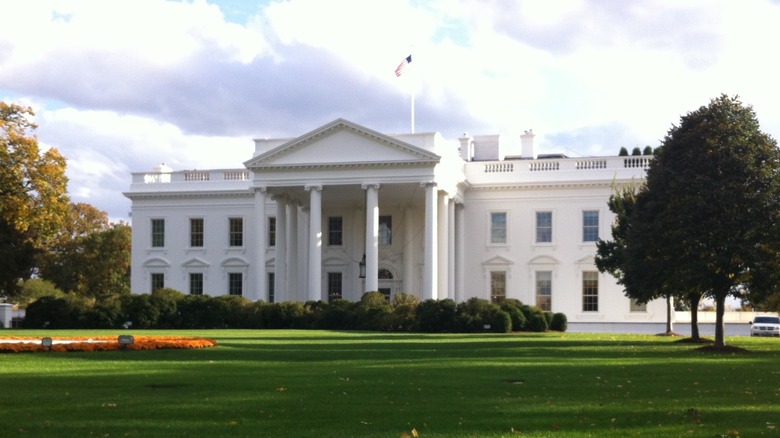No-Fly Zones: 14 Places Planes Can't Go In The USA
The sky is a wide-open expanse of seemingly endless open air. But even thousands of feet above the ground, there are still rules that must be followed. Planes can't simply fly wherever they wish. There are designated "no-fly zones" sprinkled around the United States, and if a plane wanders into them, the pilots will quickly find themselves in deep trouble with the Federal Aviation Administration, or FAA. Some areas of restricted air space are temporary, while others are permanent. Most of these no-fly zones have a vertical limit to them, which means planes can fly above the restricted area without having to change course and veer around.
Where are these no-fly zones and what makes them so special that air traffic must avoid them at all costs? That's what we're here to explain. Join us as we take a look at 14 no-fly zones across the United States and why planes aren't allowed over them.
Area 51
The Mecca for paranormal enthusiasts, Area 51 is where would-be Fox Mulders congregate, hoping to get a look at an alien spaceship. Alas, those hoping for an aerial view are out of luck, as Area 51 rests within a nearly 25 square mile patch of restricted airspace.
Some may say this is the government's scheme to withhold shocking extraterrestrial secrets from inquisitive truthseekers. The more likely explanation for the no-fly zone is that Area 51 is a cutting-edge testing ground for the US Air Force. The last thing a test pilot behind the yoke of a multi-million-dollar prototype aircraft needs is to deal with air traffic. The site is so secret that the crew of the Skylab 4 space station got into some hot water when they photographed Area 51 from space back in 1974. Whatever was going on there, the government did not want the public to know about it, be they tourists on the ground, sightseers in the sky, or astronauts in space.
Camp David
Traditionally the 'country home' of the President of the United States, Camp David is often used for strategy sessions and meetings with foreign leaders, away from the hustle and bustle of Washington D.C. The compound is located approximately 62 miles away from the White House, in Frederick County, Maryland. Typically, there's a three-mile radius of restricted airspace surrounding Camp David at all times, but that radius extends to ten miles when the President is visiting, be it for work or leisure.
In May of 2012, a pair of Cessna 172 civilian aircraft were intercepted by F-15 fighter jets for violating Camp David's airspace. The craft were escorted away from the compound and forced to land, where they were interviewed by law enforcement. This occurred during the 38th G8 summit. The G8 is now known as the G7 thanks to Russia being expelled from the forum after its first attempt to disrupt the sovereignty of Ukraine in 2014.
George Bush's Prairie Chapel Ranch
To George Bush, his Texas estate is known as Prairie Chapel Ranch. To the FAA, it's known as P-49, a strict no-fly zone, even a decade-and-a-half after he left the presidency. During his time as POTUS, the younger Bush spent a considerable amount of time at his ranch, meeting numerous foreign dignitaries there, including Tony Blair, Ariel Sharon, Angela Merkel, and many more.
While the no-fly zone is smaller than it was during Bush's time in office, P-49 still has a 2-mile radius and a vertical distance of 2,000 feet. Presumably, this is a formality akin to lifelong Secret Service protection that is granted to former presidents. For most planes, 2,000 feet isn't very high. Commercial jets usually travel over 30,000 feet in the sky, so they generally don't have to worry about traveling too close to most areas of restricted airspace.
Disney Theme Parks
In 2003, Operation Liberty Shield was initiated by the George W. Bush administration. It was an effort to make America safer from terrorism by imposing temporary flight restrictions over major cities, among other precautionary measures. As part of Operation Liberty Shield, a "no-fly zone" was put in place over America's two Walt Disney parks, Disney World in Florida, and Disneyland in California. In 2014, that rule was made permanent.
Some have argued that the true reason for the "no-fly zone" was so that Disney, one of the biggest companies in the world, could put the kibosh on aerial advertisements, i.e., private planes towing banners advertising rival theme parks or political messaging. Republican congresspeople Marjorie Taylor Greene and Lauren Boebert (the Beetlejuice lady) sponsored a bill, known as the Airlines Independent of Restrictions, or "AIR" Act, to rescind Disney's patch of restricted airspace, but it was widely seen as public retaliation for the corporation's stance on LGBTQ issues and for speaking out against Florida's controversial 2022 "Don't Say Gay" law. So far, the AIR Act has not progressed, as it was largely seen as political theater.
Naval Submarine Base Kings Bay
To put it simply, Submarine Base Kings Bay is where the U.S. Navy's Ohio-class submarines live. These submarines are noted for their offensive nuclear capability. While the threat of nuclear war isn't what it was during the height of the Cold War, the United States still maintains a sizeable nuclear stockpile consisting of thousands of missiles. These weapons can be deployed at a moment's notice, though the strategic value of weapons that can destroy the entire world with their combined might is dubious. They call it "MAD," or Mutually Assured Destruction, which is the idea that if you build a stockpile of nuclear missiles, other nations will hesitate to fire their own weapons, lest their entire continent be turned to irradiated ash.
It shouldn't be difficult to understand why a base for nuclear-equipped submarines has the privilege of protected airspace. The "no-fly zone" is designated as Prohibited Area 50 and covers all of the airspace within a two-nautical-mile radius and 3,000 feet up in the sky. People working around nuclear-equipped submarines deserve to be protected from bothersome aircraft. On the other hand, you'd have to be a lunatic to want to fly close to a base that could, at any given moment, contain nuclear weapons.
Bush Family Compound in Maine
The Bush family estate at Walker's Point, Maine, was founded by George H.W. Bush's great-grandfather, David Davis Walker. He and his son, George Herbert Walker, both had mansions built on the land back in 1905. During his presidency, the first George Bush considered the Walker's Point estate to be his "Summer White House." While his son's unofficial Summer White House was the aforementioned Prairie Chapel Ranch, he still visited Walker's Point multiple times during his tenure as President.
As there are no members of the Bush family currently in significant public office, it's likely the continued prohibited airspace surrounding the Walker's Point estate is more of a formality than a genuine instance of protecting national security, though it is something of a tourist destination. It's probably not too much of a nuisance to pilots, though, since the prohibited airspace only extends up 1000 feet in the air, which is quite low. For reference, the Empire State Building is 1,250 feet tall.
Kennedy Space Center
On July 16, 1969, when the United States put a man on the moon, they did so from Kennedy Space Center, named after President John F. Kennedy, who promised the world that, by the end of the 1960s, NASA would send an American to the Moon. Kennedy was assassinated in 1963, but his promise was kept, and the world learned that the scope of human potential wasn't limited to the Earth.
It should probably go without saying that the sky above Florida's space center is strictly forbidden, at least during the launch window for space shuttles. There's not a full-on moratorium on air travel over the site, but when shuttles are headed up or coming down, there's a strict "no-fly zone" consisting of a 30-mile radius with no vertical limit. It doesn't matter how high you can fly: the space shuttle can go higher. NASA has enough variables to deal with sending people into space; they don't need the hassle of some dunce in his private plane interfering with a shuttle launch.
George Washington's Mount Vernon Home
George Washington is called "The Father of His Country," a title he would no doubt shake his head at. He was famously a humble man: in 1783, he resigned his military commission, thus surrendering control over the Continental Army to Congress, since the military should be loyal to a country, not a man. He also stepped down from the Presidency after two terms, voluntarily giving up his power when he didn't have to. America had just established itself to escape from a monarchy, so his message, in relinquishing power multiple times, was simple: no kings.
Washington's estate in Mount Vernon, Virginia, is a popular tourist destination for those seeking a firsthand look at the life of one of America's greatest heroes. While the estate still stands, it's delicate and was not built with modern technology in mind. As such, low-flying aircraft could damage the wooden structure just by flying over it. To protect the historical site, it was designated a "no-fly zone" in 1970. As such, Washington's Mount Vernon home is designated as Prohibited Area 73, and planes cannot enter within a one-mile radius extending 1,500 feet in the sky.
Boundary Waters Canoe Area Wilderness
This is a particularly interesting case. There's not as much as there used to be, but there's still plenty of empty wilderness left in the United States. Well, maybe "empty" is the wrong word, as the Boundary Waters Canoe Area Wilderness, as it's called, is full of calm, peaceful lakes, stretches of forest, and beautiful animals, unbothered by the man-made industrialization that ravages much of the rest of the country and, indeed, the world.
This land, which comprises part of the border between Minnesota and Ontario, Canada, was protected via an executive order from President Harry Truman in 1949. This order restricted flight over the land to 4,000 feet and above. This act was seen as something of a prelude to the 1964 Wilderness Act, signed by President Lyndon Johnson, which further protected the Minnesota wilderness, designating it as public land, and thus protecting it from business interests such as logging and mining, thereby preserving its natural beauty for future generations to enjoy.
Mar A Lago (sometimes)
Rather than spend his time away from the White House at a private residence or Camp David like his predecessors, President Donald Trump instead calls the Mar-a-Lago club his home away from home. This Palm Beach resort was purchased by Trump in 1985, and, though Jimmy Carter was forced to give up his peanut farm, placing it into a blind trust, Trump managed to rake in $2.4 billion from the exclusive club during his first term, going so far as to charge the Secret Service (via the taxpayers) as much as $1,185 per room per night.
Due to its status as a presidential residence, Mar-a-Lago is protected airspace. When Trump is at the club, which is often, the restricted airspace is expanded to a 30-mile radius, ensuring that Trump's business interests are protected from low-flying aircraft. According to NORAD, there have already been dozens of airspace violations since the start of Trump's second term, likely due to pilots not realizing that Trump is at his golf course on the property, and thus the airspace is off-limits.
Naval Base Kitsap
It should be obvious why planes aren't allowed to fly over Naval Base Kitsap, located in Washington State. The base was established in 2004 when several different Naval bases on the Kitsap peninsula were combined into a single, centralized base. Naval Base Kitsap employs over 33,000 military and civilian personnel, as well as 7,500 defense contractors.
Curiously, the sky above Naval Base Kitsap is designated as P-51, which stands for Prohibited Area 51. This isn't to be confused with Area 51 in Nevada, which carries the label of "restricted" airspace, which is technically different from "prohibited" airspace. It may seem like a distinction without a difference, but "prohibited" airspace means no planes are allowed under any condition, while "restricted" airspace can have exemptions, which makes sense considering Area 51 is used for test flights of experimental aircraft... Allegedly. It could still be aliens.
The Super Bowl
The Super Bowl is one of the world's biggest annual sporting events. Tens of thousands of fans watch in the stadium and millions more watch from the comfort of their homes or local sports bars, as the two winningest teams of the year go head-to-head in pursuit of fancy Super Bowl rings. While there are no permanent "no-fly zones" over every football stadium in America (that would be impractical), there is a temporary restriction over the stadium that hosts the big game.
Typically, the restricted air space extends 18,000 feet across a 30-mile radius. In recent years, this "no-fly zone" has had to clarify that it includes aerial drones in addition to conventional aircraft. There's nothing worse than sitting down to enjoy the Super Bowl only to have a drone lose control and hit you in the face. Or, worse yet, it could wind up flying into the field, either accidentally or through deliberate sabotage, and interfere with a play... And there's already enough interference in football; just ask Tom Brady's deflated ball.
Pantex Nuclear Facility
Texas is home to not one, but two areas of prohibited airspace. The first, George Bush's Prairie Chapel Ranch, was covered earlier in this story, but the second has the potential to be much more volatile. Pantex Nuclear Facility, located in Carson County, is an assembly and disassembly plant for the nation's nuclear stockpile, and it is common sense why planes aren't allowed to fly directly over any facility that has the word "nuclear" in it... which is why it's baffling that the Indian Point nuclear power plant never had a "no-fly zone" imposed over it, but that's an issue for another time.
Unfortunately, it seems airspace violations are the least of Pantex's problems. The site has come under fire (though not literally, thank goodness) from the EPA for its poor waste management practices that poisoned the soil and groundwater, and a study by the National Institute for Occupational Safety and Health (NIOSH) found that workers at the site had a higher risk of cancer than normal. Worse yet, a 2005 incident nearly led to an accidental nuclear detonation due to mishandling of a W56 nuclear warhead in the process of being dismantled.
Washington, D.C.
Washington, D.C., is the heart of American leadership. It's where the President of the United States lives, and it's where Congress goes to work. Basically, all of Washington, D.C., is a "no-fly zone." The city is protected by a sophisticated National Advanced Surface-to-Air Missile System (NASAMS) designed to shoot down any enemy missile or stray plane that might be weaponized, accidentally or not, against the city.
If a plane violates Washington, D.C.'s prohibited airspace, it is taken extremely seriously. Secret Service agents were sent to the home of an American Airlines pilot who accidentally veered into the "no-fly zone." In 2005, a separate incident involving a student pilot accidentally wandering into prohibited airspace led to an evacuation of the White House and the Capitol building. Two F-16 jets and a Black Hawk helicopter forced the offending plane to land, surely scaring the novice pilot senseless. The vertical limit of the prohibited airspace is 18,000 feet, the highest of any of the officially designated prohibited areas.
